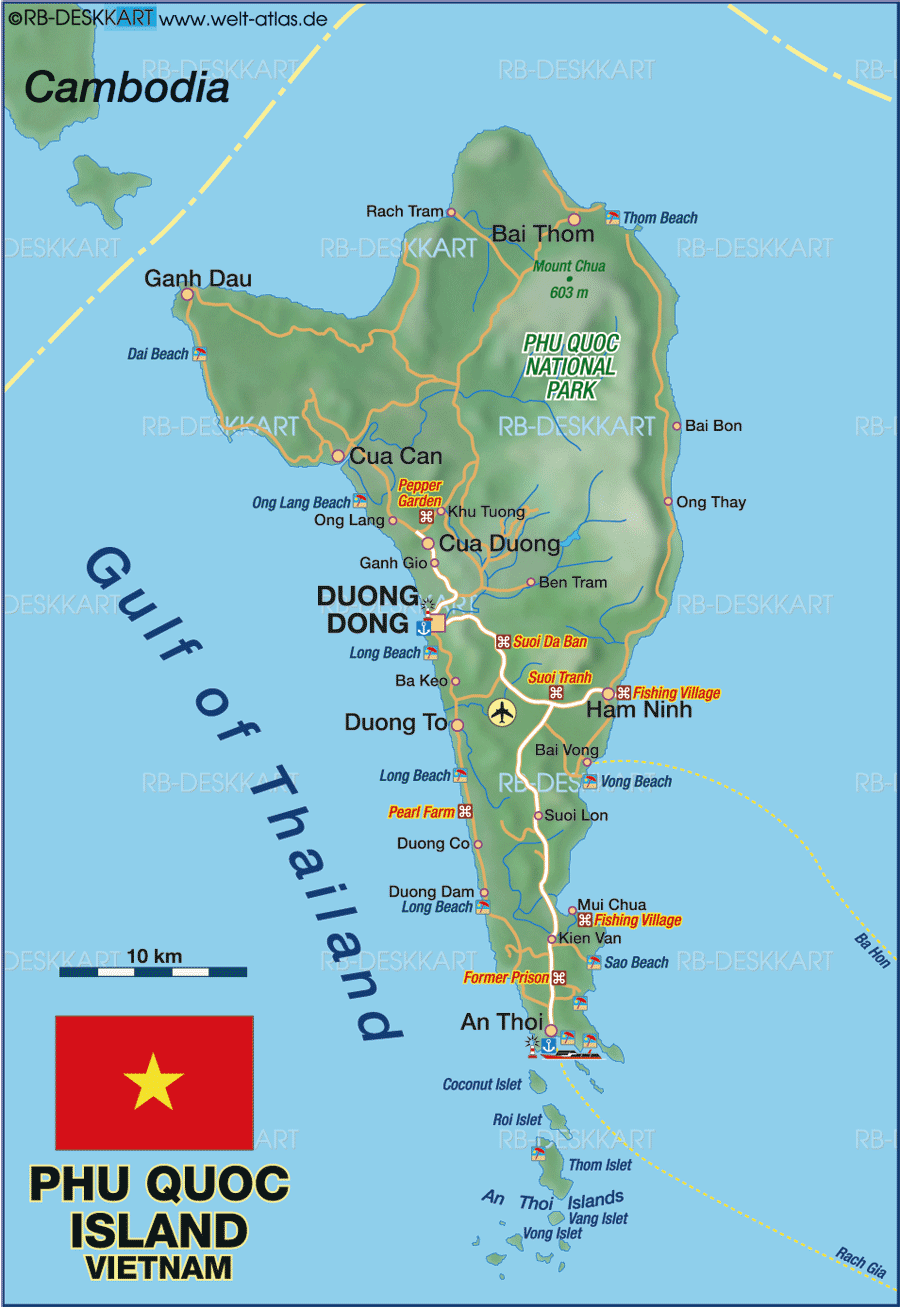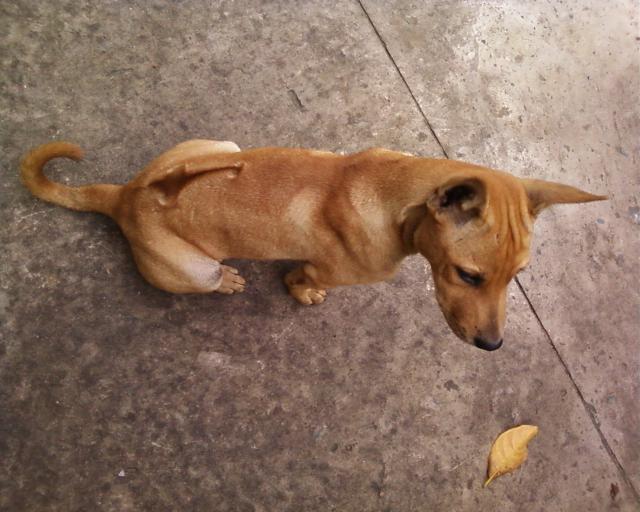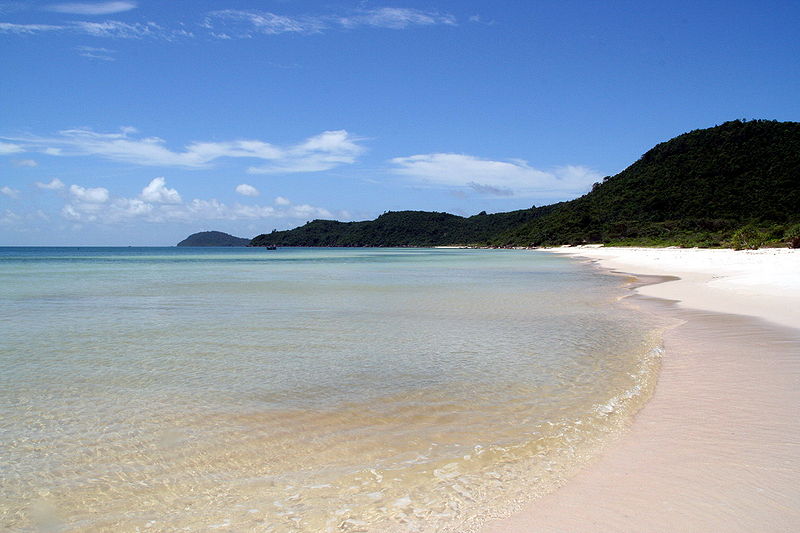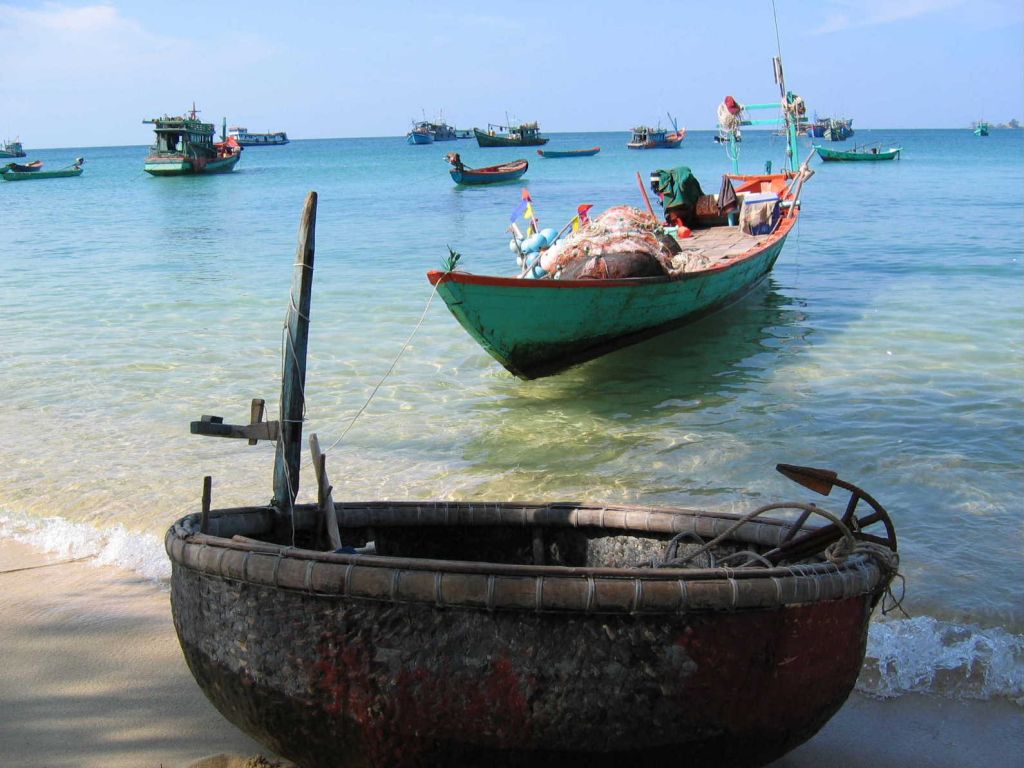| |||||||||||||||||||
| |||||||||||||||||||
http://www.wallpaperstravel.com/view/phu-quoc-island-vietnam-1280x800-travel.html
http://www.phu-quoc.de/pages_eng/karte_viet.html



http://www.terragalleria.com/black-white/vietnam/picture.viet50167-bw.html
http://discoveryindochina.wordpress.com/2010/01/04/thuyen-thung/
http://www.ncbi.nlm.nih.gov/pmc/articles/PMC544937/
http://en.wikipedia.org/wiki/Mbo_people_(Cameroon)
http://en.wikipedia.org/wiki/Littoral_Region_(Cameroon)

Are these bowl boats (Vietnamese: Thung Chai) masted for sails, parasols, nets or rudder oars? Note the red lights on top, probably for night fishing, including squid.
Phu Quoc island is mountainous within a fairly flat lowland region of the Tonle Sap lake and Mekong delta. Phu Quoc, known as Koh Tral by Cambodians (Cambodia is only 12-15 km away), is the largest island of Vietnam. Situated in the Gulf of Thailand, the island is part of Kiên Giang province. Duong Dong, halfway up the western coast, is a pleasant, unremarkable seaport with several 'nuoc mam' (fish sauce) factories (and Dinh Cau, a temple to the Whale God, full of skeletons of whales and other marine mammals used by cult devotees). Kampot is just eastwards in mainland Cambodia also grows black pepper on its mountainsides. http://en.wikipedia.org/wiki/Kampot_(town)
Quoc means national, I haven't found what the meaning of Phu Quoc is.
Diving around Phu Quoc island: north end 10m deep, south end 40m deep

Gulf of Thailand: A semi-enclosed extension of the South China Sea, the Gulf of Thailand lies between the Malay Peninsula and Indochina. Its shallow waters are largely fed by fresh river water inflow, principally from the Chao Phraya River. This river input gives the surface waters a relatively low salinity, while salt water from the main part of the South China Sea only enters deep down, pooling in areas deeper than 160 ft (50 m). Coral reefs thrive in the warm water, and there is a strong tourist industry based around good dive sites, such as the island of Ko Samui. Mangrove forests provide a buffer between land and sea along much of the coast, offering a habitat to many marine organisms
21ka - 8ka During the last Ice Age much of the Sunda Shelf of the South China Sea region was above sea level, with rainforest, wetlands and savanna: http://mnskuching.blogspot.com/2010/02/ice-age-mammals-of-borneo_07.html
http://en.wikipedia.org/wiki/Canis_lupus_pallipes Indian wolf, genetically closest to dogs,
http://en.wikipedia.org/wiki/Dog_domestication Coppinger: "My argument is that what domesticated—or tame—means is to be able to eat in the presence of human beings. That is the thing that wild wolves can't do."[15]
Phu Quoc dogs, being long islanded smallish Asian wolves lost some of their predatorial nature/fear (cf dodo bird) before being domesticated/domed by humans. Women made and owned the dome huts/boats, allowed a favored female dog (bitch) subordinate status (protector against rape/theft of food supply), male humans had to bring food to woman for status/sex/domeshelter, while male wolfdogs were excluded from the dome but favorites were allowed/fed around the area during bitch's estrus which selected for social control. In Africa and west Asia/Europe, this changed, due to preferences of dogs especially for both bowl-boat/sled pulling and hunting, such as the "ari" Hottentot ridgeback hunting dog and Congo pygmy's basenji, these were sources of large/fierce northern dogs(mastiff/misatim~basenji/bay-bark+anjin/gou=dingo)
In 2008, re-examination of material excavated from Goyet Cave in Belgium in the late 19th century resulted in the identification of a 31,700 year old dog, a large and powerful animal who ate reindeer, musk oxen and horses. This dog was part of the Aurignacian culture that had produced the art in Chauvet Cave.[22][23]
-
Addendum:
ReplyDelete

pukul (Malay) beat (gong/clock)
pulku (Lapp) boat (pulled sledboat)
pulling makes path = direction
punting/poking = suck(el)ing out/in, socket
harpoon hook-barb + punt/spoon?

...poling(E)=each of 2 points in celestial/ocelot(N/14 Tonalamatl)=sphere,=potli(N)=
pool/punt/pull/both forward and back, side to side,=
patla(N)=swap/paddle.

timaloa(N)=supperate(pun), e.g., boil&boil=
olinia(N)."
Thimbu River, roiling whitewater to Bhutan
Himba(ghee-jelled-greased hair)/Tibet(ghee-oiled bowlboat yakskin)/Himalaya(rim(e)-layered/land)
"...ches(P)=deer,=ce(N)=one offering=uentli(N)=
ciervo/cerf, but, chia/chie/ochix(N)=to wait
for someone, e.g., oc xic-chia(N)=wait a bit. "
ches, cf schield, wait at river (on shore or in bowlboat) for deer/horses to swim river, use punt-pole with end loop to slip over its head (but not strangle) cf lariat la riat/lasso/(Lhasa?)/toss(tos(P) head) (later cowboys on horses hand(h)eld rope "spoke"=punt, keeping a circle of rope spinning by partial twisting it in palm cf Chinese circle/wheel=gulu, net=gu; Malay 10 =se-pulu = punt + hoop = 1 + 0); pony-polo
"...mis(P)=name(E)=na-miqui(N)=marry/struggle;
nami(J)=wave/billow,=-nami(J/sfx)=treat someone as one of the family"
Namaqualand(Botswana) = Nagaland(Assam) = NamViet(old name)=Nam Yueh(Chin)~Yueh Zhi(PIE Toch?)
Han/Xionghua vs Hun/Xiongnu
"...suc(P)=hair=tzontli(N),=tzocatl(N)=wrinkle,
=socket/sock(E)=zoka(J)=creation."
suc = hair = fiber(hemp/kemp) of rope loop(cycle=socket) tossed/cassok-khazakh = Botai/XmBotlay/Khampa horse herders
Kokonor: Kham homeland; Numerous rivers, including the Mekong, Yangtze, Yalong Jiang, and the Salween flow through Kham.
http://en.wikipedia.org/wiki/Kham
http://thomaslkelly.smugmug.com/REPORTAGE/TIBETAN-DIASPORA/8368547_BTHk6v#!i=549014374&k=4r3nrL8
http://thomaslkelly.smugmug.com/EXHIBITION/Native-Graces/6984693_4jPH58/447036476_RcftrgR#!i=447036476&k=RcftrgR
Bhotia people, Cham dances, Kham horsemen, turquoise
Guanche (Canari island language), Dravidian/Cham-Xambotlaya:
| Bimbache | A people from Hierro | Vin-bach ("Land of the Brave") |
| Canarias | "Island of the Dogs" | Cham-ari ("Island of Cham") 3 |
| Chenech (or Chinech or Achinech) | Local name of Tenerife | Che-nek ("Pure Land") 4 |
| Echeyde (Teyde) | "The Luminous One" | Ecch-eyd or Chey-ide ("The White (or Fiery or Shiny) Mountain") |
| Gomera | One of the Canaries | Gomeda ("Fat Cattle") 5 |
| Guacimara | Name of a royal princess | Kaci-mara ("Golden Beauty") |
| Guanche | (See note 6) | Cham-che ("The Golden Heroes") 6 |
No, canari from Cham ari from XamBa Ari (people dog, or people of the dog, = arian/ainu/arinu/kenari/canari)
“found that variation within African NE1 haplotypes is significantly higher than variation within Asian and European NE1 haplotypes (p<10 sup="">−15
)….”But despite the higher variation within African NE1 haplotypes, the frequency of those haplotypes are the highest outside of Africa and, especially in America. This means that diversity is no indication of a population’s age. Plain simple. It’s likely that it shows the relaxation of a selective constraint in this region and the corresponding increase in mutation rate, which is something to be expected from a regulatory gene. Linkage disequilibrium (LD) metrics seem to support this interpretation (Amerindians again not represented):
“To understand the genomic composition upstream of the APOBEC3 locus, we first examined the phase I SNP data from the 1000 Genomes Project and identified an unusually strong linkage disequilibrium (LD) block spanning approximately 36 kb (NE1 locus, hg18 – chr22:37,600,063–37,636,026). This LD block is evident in Eurasian (CEU and CHB/JPT) populations but is absent in the Yoruban (YRI) population.”
The increase of genetic diversity as a result of the relaxation of selective constraints is something that is well described for some of modern humans’ companion species such as domesticated dogs and domesticated yaks following the domestication. A similar process must have affected their owners, too.












http://en.wikipedia.org/wiki/Pear_people